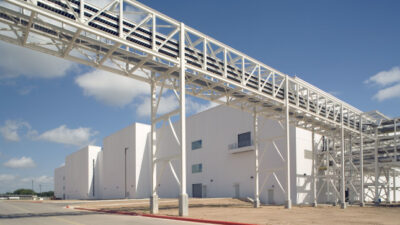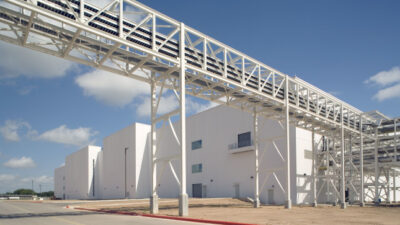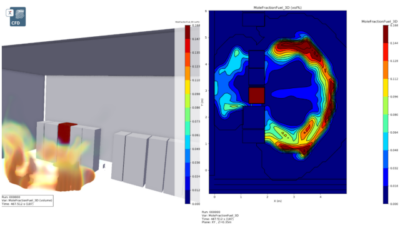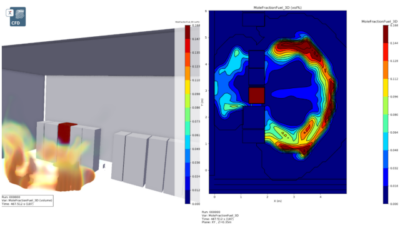When it comes to specifying clean-agent fire suppression systems in sensitive environments such as computer rooms or museums, engineers today face a smorgasbord of chemical options. It's no secret that FM-200 and Inergen dominate the clean-agent market, but several alternatives are also now available that may be even better depending on the application.
When it comes to specifying clean-agent fire suppression systems in sensitive environments such as computer rooms or museums, engineers today face a smorgasbord of chemical options. It’s no secret that FM-200 and Inergen dominate the clean-agent market, but several alternatives are also now available that may be even better depending on the application. Choosing the proper system, in turn, requires careful analysis of project goals and how a specific system meets those goals.
“What you did before may not be appropriate for every project,” says Michael J. Rzeznik, P.E., manager of the New York office of Schirmer Engineering Corp. “When it comes to property protection, you have to think about each case.”
The choices out there are many, and Rzeznik says the size of the space to be protected and the amount of clean agent required to serve that space are critical considerations. But engineers must also factor in concerns such as the amount of space needed to store the agent, system maintenance costs and overall system costs.
Before delving further, it’s helpful to step back for a moment. Halon, of course, was the traditional chemical of choice before being tagged for eventual phaseout by the Montreal Protocol of 1987 after it was determined to be harmful to the environment. Production was ordered to be phased out by Jan. 1, 1994. Its use in the United States, however, was not banned and, in fact, the agent still exists in many facilities. But with a phaseout coming eventually, most new facilities with special suppression needs have moved on to other agents in the market (see “Sizing Up Halon Alternatives,” p. 44). That said, Rzeznik adds that engineers are also considering other options—and whether a halon alternative is even necessary.
According to an industry insider who distributes clean agents, halon was often used simply because it was relatively cheap. “People put it in places where it wasn’t really needed and where they could have used something else. Today, people don’t remember what they were protecting and why the systems were put in to begin with,” says the distributor.
According to John Mahoney, P.E., fire protection specialist with Gage Babcock, Chantilly, Va., applications that once received halon systems may now be seeing water-based solutions, such as water mist. “Things change,” Mahoney says. “In some cases, museums wouldn’t have halon to begin with.”
Likewise, Rzeznik supports a trend toward more water-based systems. In many cases, gaseous fire-protection systems are used where a conventional sprinkler system would be a better and less expensive solution. Transformer rooms and electrical switchgear rooms are two examples where gaseous systems can be overused. “There aren’t many cases where you can’t use sprinklers vs. halon [or halon alternatives],” Rzeznik says.
Rzeznik also reminds his colleagues that ownership choice and property protection—not building codes—determine where chemical-based suppression systems are used. “The building code doesn’t tell you where to install that type of system; it tells you how to install it. Understanding the end users’ protection concerns is the best guide when determining if and what kind of gaseous system should be designed,” he says.
Moving forward
While clean agents have their place, there’s still a lot of confusion out there. “In the days after the halon production bans, people were confused and opted to do nothing. Then FM-200 emerged as the ‘choice,'” notes our distributor insider. “Now, there are lots of choices, but people are back to that post-halon confusion. It’s not as bad as it was, but it’s there.”
The good news is that there are a number of informative resources available: NFPA Standard 2001 (2004 edition); UL listings and FM approval guides; the U.S. EPA SNAP list; and individual system manufacturer websites. Our distributor also reminds us that manufacturers are also open to presenting personalized “lunch and learn” sessions.
The trend toward green buildings and the growing importance of LEED certification is another influence on decisions today, adds Rzeznik. Because of both a zero global warming potential and a zero atmospheric lifetime count, Inergen and Chemetron’s Argonite, he says, have been popular. The newest player to the green scene is 3M and its Novec 1230 product, which company officials claim has a global warming potential of only 1.0.
From Rzeznik’s perspective, the biggest hurdle for some manufacturers of the newer halon alternatives may be overcoming the psychological and emotional ties some engineers may have to certain products.
“There are some engineers who always use the same agent for all applications because they have developed a comfort level with its design, not necessarily because it is the best agent for the job,” Rzeznik says. “The bottom line is that all the options work.”
That said, he adds appropriate considerations should be given to all of the agents, “particularly if it is in the best interest of the client.”
Cost of Agent to Flood a 10,000 ft3 Room at 70°F
Commercial Name
Design Concentration
Amount of Agent
Unit Cost
Total Cost
Source: Schirmer Engineering
FM-200
7%
341 lbs.
$12/lb.
$4,092
FE-13
18%
450 lbs.
$11/lb.
$4,950
FE-25
1%
274 lbs.
$13/lb.
$3,562
Novec 1230
7%
372 lbs.
$12/lb.
$4,464
Inergen
34%
4,270 ft3
$1.65/ft3
$7,046
Argonite
37.9%
4,760 ft3
$1.13/ft3
$5,379
Halon 1301
5%
184 lbs.
$19/lb.
$3,496
Facts and Figures
Key issues to keep in mind about halon and halon alternatives:
Halon use has not been banned in the United States, but production has been stopped, largely to prevent unnecessary emissions of ozone-depleting halon into the atmosphere. Existing halon systems may remain in operation if they are functioning properly and are maintained properly. Recycled halon may be purchased legally, but continued supply is not guaranteed.
According to the 2002 Report of the HFC Emissions Estimating Program (HEEP), emissions of hydrofluorocarbons (HFCs), perfluorocarbons (PFCs) and sulfur hexafluoride (SF6) represent less than 3% of all greenhouse gas emissions in the world; and emissions of HFCs and PFCs used in fire protection as non-ozone-depleting alternatives account for less than 1% of total HFC and PFC emissions. Carbon dioxide, methane and nitrous oxide account for 97% of all greenhouse gas emissions.
According to the European Climate Change Programme directives being developed in the European Union, HFC-134a used in new car air-conditioning systems will be gradually phased out between 2009 and 2013. HFCs used in fire suppression are not being targeted for phaseout; emissions will be controlled through efforts of containment and monitoring.
In a letter responding to concerns about the future of U.S. policy on the use of HFCs in fire protection, Drusilla Hufford, director of the Stratospheric Protection Division of the U.S. Environmental Protection Agency, writes, “EPA does not anticipate any change to its acceptability listing of HFCs in fire suppression applications. The availability of halon substitutes such as HFCs have been key in achieving the significant progress made to date and will continue to be important in eliminating the use of halons in the U.S. and globally.”
Sizing Up Halon Alternatives
Since the 1960s, the choice for protecting electronic equipment and other irreplaceable assets was simple: Halon 1301. Halon was determined to be harmful to the environment, and as part of the Montreal Protocol of 1987, production was phased out by Jan. 1, 1994. The problem was finding a suitable replacement for Halon 1301 that would not be harmful to the environment. Following is a summary of attributes of the key halon alternatives available today:
FM-200 (Great Lakes Chemical). A compound of carbon, fluorine and hydrogen, this chemical is considered a halocarbon agent. It extinguishes fires by both physically removing heat from the flame and through interruption of the chemical chain reaction. Because FM-200 acts as a refrigerant and lowers the pressure in the room, no pressure venting is required. However, if fire reaches temperatures in excess of 900°F, halogen acids, particularly hydrogen fluoride, can occur upon exposure to flames. The maximum fill density of the agent storage is 70 lbs. per cu. ft.—or 80%—which takes approximately seven times less storage space than systems based on carbon dioxide and inert gases. Because it is colorless, odorless and electronically nonconductive, it leaves no residue and eliminates post-fire clean up.
Inergen (Ansul). The leading competitor to FM-200 as a clean-agent system, this chemical is a mixture of three naturally occurring gases—nitrogen, argon and carbon—and, therefore, does not pose the environmental concerns associated with the chemically derived halon alternative agents. Inergen does not contribute to global warming and has no atmospheric lifetime. Inergen will not break down into toxic or corrosive decomposition products when coming in contact with fire. However, because of pressure increase when the Inergen agent is discharged into an enclosure, pressure venting is required, which can add to construction costs and impact system and enclosure design.
FE-13 (DuPont). A high-pressure clean agent, its low boiling point makes it ideal for low-temperature applications as low as -40°F. These systems are also suitable for high ceilings having a UL-listed, 25-ft. maximum nozzle height.
FE-25 (DuPont). Also known as HFC-125, this agent demonstrates the closest physical resemblance to Halon 1301 in terms of both flow characteristics and vapor pressure, making FE-25 a relatively easy replacement option for existing Halon 1301 systems with minimal system modifications. The pressure traces and spray patterns of the two agents are identical.
NOVEC 1230 (3M Fire Protection). The first clean agent fluid, this chemical works as a gas when extinguished, but exists as a liquid at room temperature. Novec 1230 offers the lowest global warming potential for halocarbon alternatives and the lowest atmospheric life for halocarbons (five days). One advantage of a liquid agent is that it can be shipped in drums and totes rather than pressurized cylinders. Also, if a leak occurs in the system after super pressurization, the nitrogen can be vented easily and the agent retained while repairing the cylinder seal or gasket.
Sizing Up Halon Alternatives, Part 2
Every clean agent has its particular strengths and weaknesses and any one of the agents mentioned could be the appropriate choice for a particular application.
Due to its proven effectiveness, Great Lakes’ FM-200 is the most popular choice in clean-agent suppression systems today. It is safe and effective, has few side effects to consider and is relatively inexpensive, making it a good choice when considering clean agents. Many people are comforted by the fact that it has been around for 10 years and there are many systems installed and operational today.
Ansul’s Inergen, a mixture of nitrogen, argon and carbon, is an excellent choice for a clean agent system when the environmental impact of the agent is of the greatest importance. Companies interested in the optimal “green” building choice may choose Inergen to protect their most valuable assets. Inergen will continue to meet future environmental regulations because it has no environmental impact, so there is no reason for future environmentally based legislative concerns.
Chemetron’s Argonite is a 50:50 mixture of argon and nitrogen. An Argonite discharge results in a gas mixture with a density similar to that of air; therefore, hold times are greatly increased and the need for room sealing is reduced.
In special applications, FE-13 can be the most appropriate clean agent. As previously mentioned, it is superior to all other agents in low-temperature applications. It has been proven effective in offshore oil platforms, pumping stations, mining equipment and locomotives. FE-13 can also be used in high ceilings where other agents cannot, such as larger computer room or data processing facilities, or libraries, cathedrals and museums with high ceilings.
When existing Halon 1301 systems seek a “drop-in” replacement, FE-25 deserves prime consideration. As international regulatory bodies begin to mandate the removal of Halon 1301 from total flooding applications, FE-25 will be beneficial to these system transformations. In some cases, minimal system modification is required, avoiding the need to renovate the entire system.
Novec 1230 offers a clean agent liquid with many advantages over gaseous agents. It is easy to charge and handle, not having to deal with super-pressurized cylinders. The fact that it is a liquid means that Novec 1230 can be shipped in large quantities, saving money and time in shipping. But some consumers may not like the idea of having highly pressurized gases stored in their building. For these reasons, Novec 1230 is a unique solution for specific customers.
In all, each clean agent has advantages over the others. Depending on the particular application and needs of the consumer, any clean agent can be the most appropriate. Although there are many differences between the agents, all are effective in meeting current environmental requirements and extinguishing fires. However, it is important to understand each of the agents when deciding which clean agent is right for the project.



